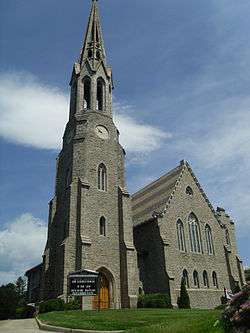Putnam Hill Historic District
|
Putnam Hill Historic District | |
 | |
  | |
| Location | U.S. 1, Greenwich, Connecticut |
|---|---|
| Coordinates | 41°2′11″N 73°37′9″W / 41.03639°N 73.61917°WCoordinates: 41°2′11″N 73°37′9″W / 41.03639°N 73.61917°W |
| Area | 36 acres (15 ha) |
| Built | 1830 |
| Architect | Vaux,Calvert; Multiple |
| Architectural style | Mid 19th Century Revival, Late 19th and 20th Century Revivals, Late Victorian |
| NRHP reference # | 79002657[1] |
| Added to NRHP | August 24, 1979 |
The Putnam Hill Historic District encompasses a former town center of Greenwich, Connecticut. Located on United States Route 1 between Millbank Avenue and Old Church Road, the district includes the churches of two historic congregations, a former tavern, and a collection of fine mid-Victorian residential architecture. The district was listed on the National Register of Historic Places in 1979.[1]
Description and history
Greenwich's Putnam Hill area became a secondary center to the town (after Old Greenwich) at least as early as 1702, when the Second Congregational Church was located there. It was also home to Greenwich's town hall between 1825 and 1874, which was located where the town's Civil War memorial now stands. During the American Revolutionary War it was the scene of an escape of Continental Army General Israel Putnam from surrounding British forces by riding his horse down the steep hill from the Putnam Cottage, a feat that gave the area its present name. The Putnam Cottage, formerly Knapp's Tavern, was built about 1700, and is now a museum. In the years after the American Civil War, the area developed as a fashionable residential area, with several fine period residences surviving, including the Chateauesque Tomes-Higgins House, which was designed by architect Calvert Vaux. It was also where Boss Tweed had his country estate.[2]
The district is basically linear in extent, running from Millbank Drive in the west to Old Church Road in the east. The district has 21 contributing buildings, most of which are residential. Other features of the district are two small parks, a stone marker placed by the DAR commemorating Putnam's ride, and the gateway to the former Jeremiah Millbank estate, which is the only surviving element of the Tweed estate.[1][2]
See also
References
- 1 2 3 National Park Service (2009-03-13). "National Register Information System". National Register of Historic Places. National Park Service.
- 1 2 Charles W. Brilvitch (October 1978). "National Register of Historic Places Inventory-Nomination: Putnam Hill Historic District / Putnam Hill National Register District". National Park Service. and Accompanying 13 photos